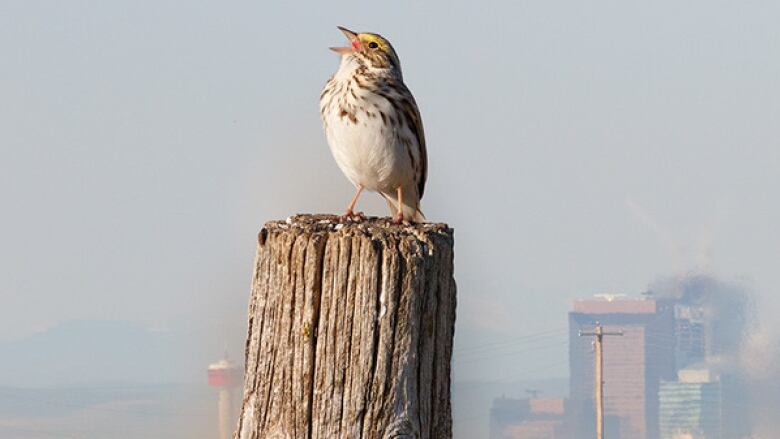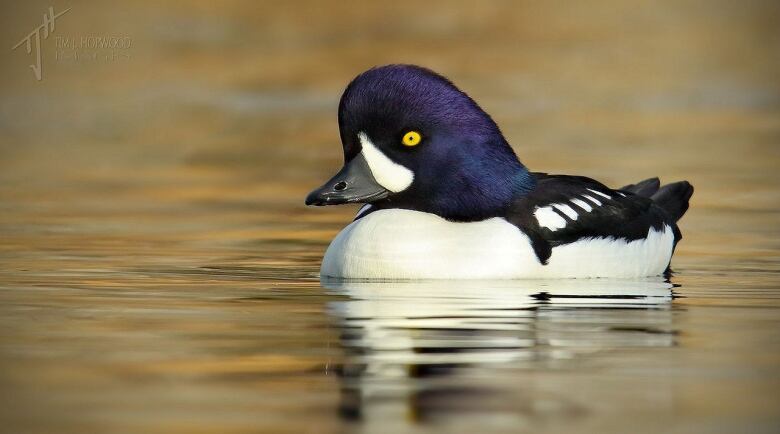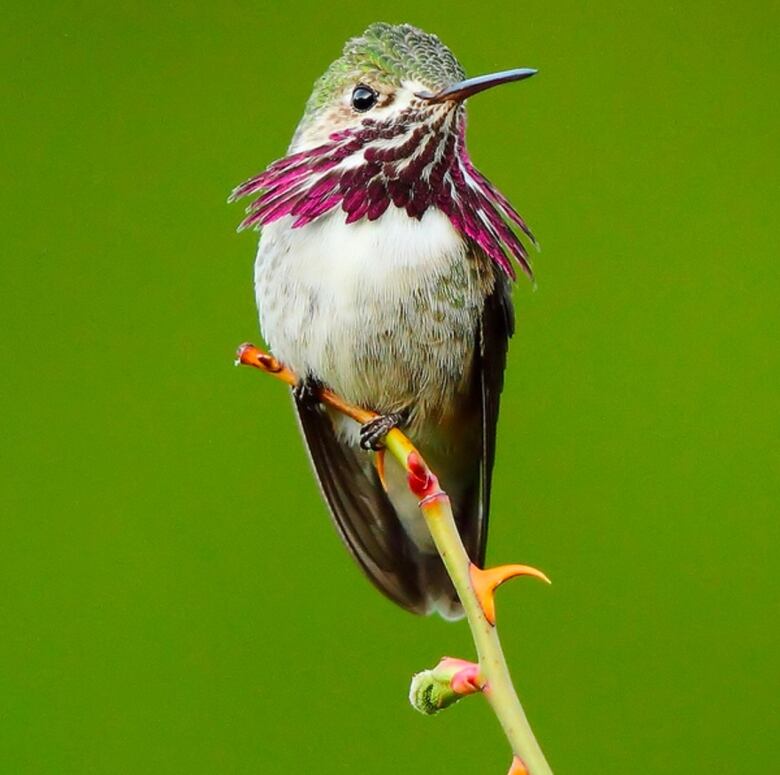Calgary critters: check out who calls your neighbourhood home
'Calgary is an uncommonly good city in which to meet wildlife'

For more than four years, Bob has been watched very closely.
A group of dedicated Calgarians have regularly gone looking for him in our city's coldest and darkest shadows. Sometimes Bob comes out to greet them. And sometimes not. He neither shuns nor seeks their affection that is, until you offer him food.
You see, Bob, is a rare and elusive find.
A red-breasted nuthatch. A song bird.

He's got a genetic quirk that messes up the black pigments in his feathers, giving him a snowy face. And for wildlife watchers in our city, that makes Bob a local celebrity.
Wild in YYC
Calgary is an uncommonly good city in which to meet wildlife.
You name it, we've got it. Over 300 species share the city with us. Elk, bears, otters, deer, butterflies, coyotes, squirrels and a plethora of birds. And we can thank our geography for all of it.
As our best-known naturalist Brian Keating says, "we are extremely lucky to have clear, clean mountain rivers flowing through our city, essentially placing wildlife corridors right into the heart."

Like a dart, the Bow, Elbow and Fish Creek valleys propel critters into our neighbourhoods. These corridors connect our parks and green spaces to the wild lands to the west, and so every now and then elk, black bear, river otter and moose wander right into town.
This provides a "wild"thrill creating something like a wilderness psychology for urbanCalgarians. Just knowing we can spot wildlife in our backyardsencourages us to look for it. Making it part of our daily identity.
So, let's take a wander around our neighbourhoodsand check out the wildlife.
Where east meets west
Calgary is where the old west meets the new west. Let's look at Fish Creek Provincial Park.
Originally mule deer roamed the rolling hillsides and shrubby coulee bottoms of an undeveloped Alberta. But they're now being outnumbered by the more recent white-tails.Turns out, that's on us.
White-tailed deer followed the homesteaders west through farmlands.
Today, they are commonly found in our urban green spaces like Carburn and Nose Hill parks, where a dozen or more can be seen on a single visit. Residents in Riverbend, Deer Ridge and Thorncliffe are also sure to receive late night visits.
For the most part, these deer come and go unnoticed. That is, until fall comes aroundand majestic bucks go on parade and theirwhite-tails shine.

Like our deer, predators both old and new also converge in Calgary.
The yippycalls of coyotes have filled our springtime evenings since the formation of the Bow River valley. But our wild cats are a different story.
From a stronghold in the foothills, bobcats have only recently found the new Calgary to their liking. Right now there are probably less than a dozen bobcat families scattered in neighbourhoods like Varsity, Britannia, Parkland, Haysboro and Lake Bonaventure, but their numbers are growing.
While some prey and predators make their homes in our neighbourhood parks, others are more at home in our urban sprawl.
Squirly over wildlife
Some of our best-known wild critters call the streets home, either as new arrivals, recent converts or part-time tourists.
The best-known newcomer to Calgary is the eastern grey squirrel. It's name is a head scratcher. While some of our Calgary squirrels are grey, most are black. This is something of a quirk, as black squirrels are pretty rare elsewhere.
So, here's the story.
Most of the 100,000 or so squirrels in Calgary (an isolated population) are descendants of pets and zoo escapees from the 1930s. These sneaky critters then accomplished a feat of exponential growth that would make our randiest rabbits jealous.

In the wilds of our Calgary backyards, the escapees faced the worst winter conditions of any of their kind. Survival was tough. And so, they developed a secret weapon. Sunbathing.
In the dead of winter they're often seen on tree trunks, head down, stretched out and catching rays. Why? The thinking goes that by doing this, the super sun-soaking black squirrels soaked up more heat than the grey ones. Throw in a little Darwinian natural selection, and voila! Black squirrels.
Our black squirrels live pretty much all over town, but are especially dense in parks like Prince's Island, Pearce Estate and Glenmore Parks.
And Calgary has other newcomers flocking to town.
Birds of a feather
The house finch is ubiquitous in Calgary, but the eurasioncollareddove is soon to be ubiquitous. They're rapidly moving into yards from Chapparal to Saddle Ridge.
Calgary also sees its share of feathered layovers with more than 150 different kinds of bird migrants. They pass through without even stopping to lay an egg, as they prefer wilder areas to nest and warmer places to spend the winter. But a keen eye can spot them.

Check out Bebo Grove, InglewoodBird Sanctuary and Coronation Park for warblers, flycatchers, vireos and tanagers. Every May, these bring a fleeting splash of exotica to our parks. Fortunately for Calgarians with a love of colour, there are other options to explore that are here through the entire summer.
Black-billed magpies, northern flickers and American robins have always been here, but in our urban areas they now live in densities up to ten times higher than in more natural environments.
And just like people in our urban environment, some birds like to live in particular neighbourhoods.
Hummingbirds provide Calgary's greatest feathered visual bouquet. From their point of view, Calgary isn't a single city. Rather, there are two hummer-hoods in town split along a line that basically follows Crowchild Trail in the northwest, and down along Macleod Trail in the south.

On the eastern side, ruby-throats dart through Union Cemetery and yards in Willow Park. To the west, rufous and Calliope hummingbirds buzz through spruce tops in Oakridge and Woodlands. There may be no other city where you can find these three types of hummingbirds.
In fact, our city offers a lot of unique combinations. Only in Calgary, in a single morning, have I seen: myrtle and audubon's warblers; white-tailed jackrabbits and snowshoe hares; wood ducks and Barrow's goldeneye.
These animals live with us. They are a part of who we are as a city.
From the brown and rainbow trout of the Bow River, to thecrimson-streaked long-nosed suckers ofFish Creek. From the 75 species of butterflies in our shrubs, to the omnipresent ladybugs in our gardens.
Building by connecting
The wildlife community that we choose to live alongside in Calgary has grown from the fusion of time, places and living things.
In turn, our wildlife influences Calgary's human population. As Brian Keating says, "our access to wildlife and wild locations within the city are part of the magic that helps to attract and keep good people, smart people, to this place."
For many of us, wildlife is part of our community's identity. It's family. We get to know characters like Bob the nuthatch and others just like him. These encounters connect us more deeply with the community where we choose to nest.












_(720p).jpg)


 OFFICIAL HD MUSIC VIDEO.jpg)
.jpg)



























































































